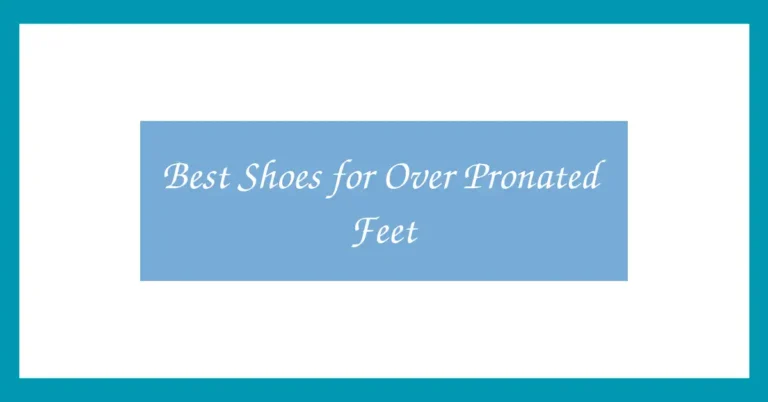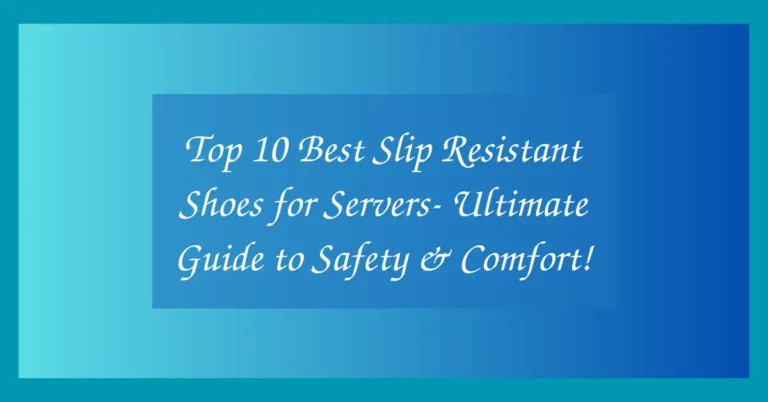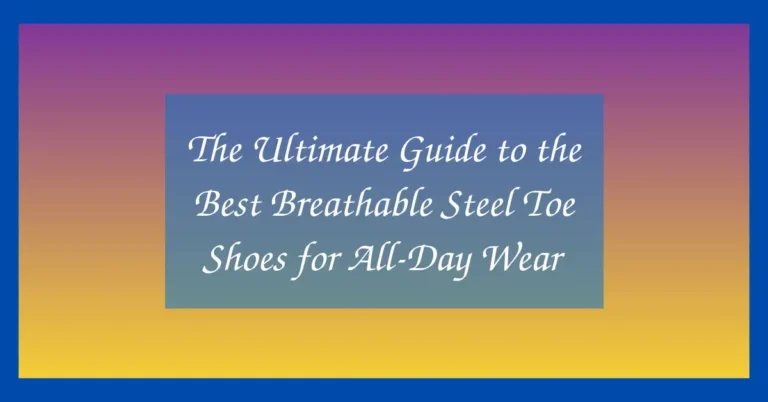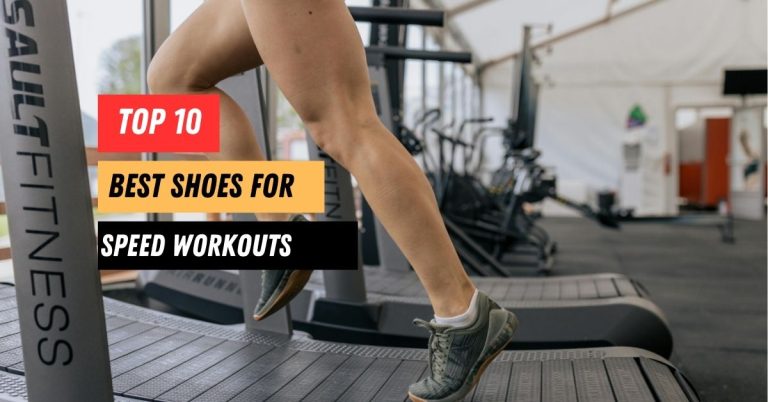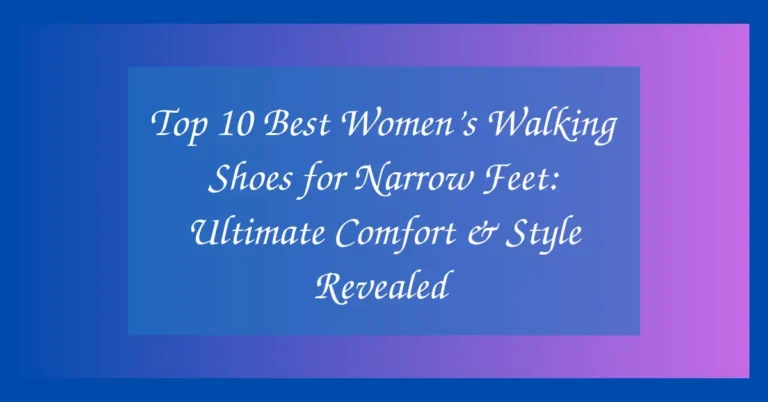Best Shoes for Ehlers Danlos Syndrome
When living with Ehlers-Danlos Syndrome (EDS), a group of disorders affecting connective tissues, finding the right shoes becomes more than just about fashion; it’s about health and mobility. Proper footwear is essential for those with EDS to manage symptoms and maintain as much physical activity as possible without risking injury. The right shoes can provide necessary support, reduce pain during movement, and help in stabilizing joints that may be prone to dislocation.
This article aims to guide you through selecting the best shoes tailored to meet the needs of individuals with Ehlers-Danlos Syndrome, ensuring that each step taken is as safe and effective as possible.
Top 10 Shoe Reviews for Ehlers-Danlos Syndrome
Finding the right shoes can significantly impact comfort and mobility for those with Ehlers-Danlos Syndrome (EDS). Here are detailed reviews of the top 5 shoes that are suitable for managing the symptoms associated with EDS.
Table of Contents
Toggle1. Orthofeet Orthopedic Men’s Sneakers
Orthofeet Orthopedic Men’s Sneakers are specifically designed to cater to those requiring extra foot support and comfort. These sneakers feature a smooth interior lining and extra foam padding that enhance comfort and protect sensitive feet. They also boast ergonomic soles with a mild rocker design, improving the ease of walking and adding spring to your step.
Orthofeet’s Orthopedic Men’s Sneakers offer an impressive combination of support and cushioning. The premium orthotic insole and the cushioning soles work together to alleviate stress on the joints, enhancing stability and support. The shoes come with a non-binding, extra-depth design and a wide toe box that helps relieve pressure on bunions and hammertoes.
The soft, seam-free interior lining is made for sensitive feet, which reduces the risk of skin irritation. Additionally, the easy gait ortho-cushion system of the soles helps soften step and enhance stability, proving ideal for EDS patients who need extra joint protection.
Pros:
- Excellent arch support and cushioning
- Wide toe box and extra depth for custom orthotics
- Soft, seam-free interior lining ideal for sensitive skin
- Enhances stability and reduces joint stress
- Available in a variety of widths
Cons:
- Higher price point
- Limited style and color options
- May be too bulky for some users
2. Vionic Walker Classic Shoes
The Vionic Walker Classic Shoes are renowned for their orthotic-friendly design that combines casual styling with advanced motion control. They include a leather upper with brushed nylon lining and a firm, thermoplastic heel counter for increased support and stability.
Vionic Walker Classic Shoes stand out due to their active motion system technology, which provides optimal walking support. The built-in Orthaheel orthotic is a unique feature that reduces overpronation, thus easing the stress on feet, ankles, and knees. The shoes offer a cushioned collar and tongue, removable textile-covered EVA footbed, and a durable rubber outsole designed to improve traction.
Despite their robust support features, these shoes maintain a stylish look that fits well in both casual and business casual settings. Their shock-absorption capabilities are also notable, making them an excellent choice for everyday wear by those with EDS.
Pros:
- Integrated motion control technology
- Supportive orthotic footbed
- Stylish design suitable for various occasions
- Durable construction with effective shock absorption
- Good traction for safety
Cons:
- Some users report a break-in period
- Not as breathable as other models
- On the heavier side
3. New Balance 990v5 Running Shoe
Designed for durability and comfort, the New Balance 990v5 Running Shoe combines practicality with a classic, understated style. These shoes feature a strong rubber outsole, dual-density collar foam, and an ENCAP midsole technology that provides support and maximum durability.
The New Balance 990v5 Running Shoe is a robust contender in the realm of footwear suitable for EDS. It offers exceptional support and cushioning, thanks to its ENCAP midsole technology, which combines lightweight foam with a durable polyurethane rim to deliver support and maximum durability.
The shoe’s breathable mesh upper, coupled with a dual-density collar foam, prevents irritation while providing snug, comfortable fit. The substantial rubber outsole offers secure traction, essential for those with joint instability. These shoes also boast a classic design that appeals to users of all ages, making them a versatile addition to any wardrobe.
Pros:
- Superior cushioning and support with ENCAP midsole
- Durable and reliable construction
- Classic design and wide range of sizes
- Breathable upper and comfortable collar foam
- Excellent traction for stability
Cons:
- Premium price range
- May be too stiff for some users at first
- Heavier compared to other running shoes
4. Brooks Adrenaline GTS 21
Brooks Adrenaline GTS 21 is specifically engineered for those who need reliable support that doesn’t compromise on cushioning. It features the latest in GuideRails support technology, which is ideal for protecting vulnerable joints.
The Brooks Adrenaline GTS 21 excels in delivering an optimal balance of support, cushion, and responsiveness. Its innovative GuideRails support system focuses on protecting your knees by keeping excess movement in check, which is particularly beneficial for EDS sufferers.
The shoe’s DNA LOFT crash pad cushions each step and works with the BioMoGo DNA to adapt to your every stride, providing a dynamic and comfortable fit. With a breathable mesh upper and a modern, streamlined design, the Brooks Adrenaline GTS 21 not only feels good but also looks great whether you’re running errands or taking a jog.
Pros:
- Advanced GuideRails support system
- Excellent cushioning with DNA LOFT crash pad
- Adaptable fit with BioMoGo DNA
- Breathable and stylish design
- Suitable for running and everyday use
Cons:
- Slightly higher price point
- May not be suitable for those who prefer a minimalistic shoe
- Limited color options in certain sizes
5. Skechers Go Walk Arch Fit – Grateful
Skechers Go Walk Arch Fit – Grateful shoes are designed for ultimate comfort and support with their Arch Fit insole system and lightweight, responsive ULTRA GO cushioning.
Skechers Go Walk Arch Fit – Grateful shoes are a testament to comfort and functional design. The patented Arch Fit insole provides podiatrist-certified arch support that distributes pressure evenly across the foot, reducing impact on pain points. The lightweight ULTRA GO cushioning feels responsive and provides effective shock absorption with every step.
The soft, woven mesh fabric upper offers a comfortable fit and breathability, while the slip-on design makes them easy to wear. These shoes are perfect for everyday activities, providing the comfort and support needed by those with EDS without sacrificing style.
Pros:
- Podiatrist-certified arch support
- Lightweight and responsive cushioning
- Breathable mesh fabric upper
- Easy slip-on design
- Stylish and functional
Cons:
- Not as durable as some other models
- Limited ankle support
- May run small, requiring sizing up
6. Propet Stability Walker
Propet Stability Walkers are designed with a focus on comfort and stability, featuring a leather upper, rigid heel counter, and a padded collar and tongue for extra cushioning.
Propet Stability Walkers offer excellent support for those with EDS due to their enhanced stability and cushioning features. The shoe’s durable leather upper provides structural integrity, while the padded collar and tongue offer additional comfort. The rigid heel counter and wide base enhance stability, reducing the risk of slips and falls.
The removable footbed accommodates custom orthotics, making this shoe highly customizable. Additionally, the lightweight, cushioned EVA midsole absorbs shock, easing the impact on joints during walking. Its simple design ensures that it blends seamlessly into any wardrobe, making it suitable for both casual and more formal occasions.
Pros:
- Enhanced stability with a rigid heel counter
- Padded collar and tongue for extra comfort
- Removable footbed suitable for custom orthotics
- Durable and shock-absorbent EVA midsole
- Versatile design for various occasions
Cons:
- Limited breathability due to leather upper
- Some users find the style outdated
- Relatively heavy compared to modern athletic shoes
7. Asics Gel-Kayano 27
Asics Gel-Kayano 27 is known for its dynamic DuoMax Support System and GEL technology cushioning, which are ideal for those requiring both support and comfort in their stride.
Asics Gel-Kayano 27 shoes are a popular choice among runners, but they also serve well for those with EDS due to their excellent stability and cushioning. The DuoMax Support System enhances foot stability and support, while GEL technology provides superior shock absorption, crucial for protecting joints.
The engineered mesh upper offers great breathability and a comfortable fit, adapting to foot movements. These features make the Gel-Kayano 27 ideal for both everyday activities and exercise routines, providing the necessary support to manage EDS symptoms effectively.
Pros:
- DuoMax Support System enhances stability
- GEL technology for superior shock absorption
- Breathable, flexible mesh upper
- Suitable for both daily wear and exercise
- Modern and stylish design
Cons:
- High price point
- Can be too narrow for some foot types
- Requires a break-in period for optimal comfort
8. Merrell Jungle Moc
Merrell Jungle Moc offers a casual slip-on design with heavy-duty support and cushioning, featuring an air cushion in the heel for shock absorption and a molded footbed for comfort.
Merrell Jungle Moc is an ideal shoe for those seeking a blend of simplicity and functional support. The shoe’s air cushion heel and sturdy sole work together to provide significant shock absorption and stability, crucial for individuals with EDS.
The molded footbed enhances comfort, conforming to the shape of the foot. Its slip-on design makes it highly practical, eliminating the need for laces, which can be challenging for those with joint issues. The suede upper adds a touch of style while maintaining durability and comfort.
Pros:
- Air cushion in the heel for excellent shock absorption
- Molded footbed for enhanced comfort
- Easy slip-on design
- Durable suede upper
- Versatile for casual and outdoor wear
Cons:
- Suede may require more maintenance than other materials
- Limited arch support for some users
- Typically heavier than other casual shoes
9. Clarks Unstructured Un.Loop
Clarks Unstructured Un.Loop is designed for ultimate comfort with a unique air circulation system and an ultra-flexible sole, making it perfect for sensitive feet and joint issues.
Clarks Unstructured Un.Loop stands out for its innovative design that emphasizes comfort and breathability. The shoe features a unique air circulation system that keeps feet cool and dry, reducing the risk of irritation. Its ultra-flexible sole and soft leather uppers provide comfort and ease of movement, important for those with EDS.
The shoe also offers a button closure that is both stylish and functional, making it easy to put on and take off. This model combines style with practicality, making it a suitable choice for everyday wear.
Pros:
- Unique air circulation system for enhanced breathability
- Ultra-flexible sole for ease of movement
- Soft leather upper for comfort
- Easy-to-use button closure
- Stylish design suitable for various settings
Cons:
- Higher cost relative to basic comfort shoes
- May lack sufficient support for severe EDS cases
- Leather requires care to maintain appearance
10. Nike Air Zoom Pegasus 36
Nike Air Zoom Pegasus 36 offers a sporty design with advanced cushioning and responsiveness, featuring Zoom Air units and a Cushlon ST foam for smooth, responsive rides.
Nike Air Zoom Pegasus 36 is a top choice for those who need a combination of responsiveness, cushioning, and style in their footwear. The Zoom Air units in the forefoot and heel provide rapid energy return, adding a spring to each step, which can help reduce the strain on joints.
The Cushlon ST foam ensures long-lasting cushioning, making the shoe comfortable for prolonged wear. Its sleek, engineered mesh upper enhances breathability and provides a snug, comfortable fit. This shoe is suitable for both athletic activities and daily wear, offering great versatility and support for EDS sufferers.
Pros:
- Responsive Zoom Air units in the sole
- Long-lasting Cushlon ST foam cushioning
- Breathable, engineered mesh upper
- Stylish and versatile design
- Suitable for sports and everyday use
Cons:
- Premium pricing
- May not provide enough arch support for all EDS patients
- Slightly less durable for high-impact activities
Buyer’s Guide
Selecting the best shoes for Ehlers-Danlos Syndrome involves more than just picking a comfortable pair. Here’s how to find shoes that help manage EDS symptoms effectively:
-
Support: Shoes with excellent arch support and firm ankle structures are crucial as they help stabilize loose joints, potentially reducing subluxations and dislocations. Features like contoured footbeds and orthotic-friendly designs can provide additional support where it’s needed most.
-
Comfort: EDS often comes with associated pain, especially in the feet and ankles. Look for shoes with ample cushioning and soft, seamless linings to minimize irritation. Memory foam or gel insoles can offer extra comfort and shock absorption.
-
Durability: Durability is important because shoes that break down quickly could fail to provide the necessary support over time. Choose shoes with robust materials and excellent craftsmanship. High-quality synthetic fibers or sturdy leathers are often good choices as they maintain their shape and structural integrity.
-
Grip: Good traction is essential to avoid slips and falls, which can be particularly hazardous for someone with EDS. Look for soles made from non-slip rubber with deep grooves or patterns that enhance grip on various surfaces.
-
Flexibility: While support is critical, some flexibility in the forefoot of the shoe can aid in natural foot movement and prevent undue stress on the joints. However, avoid overly flexible shoes that provide little to no support.
-
Adjustability: Shoes with adjustable straps or laces can accommodate fluctuations in foot size due to swelling, a common issue in those with EDS. This feature allows for a more customized and supportive fit throughout the day.
-
Material: Breathable materials such as soft, natural fibers can keep the feet cool and dry, reducing the risk of skin irritation and discomfort. Avoid materials that are too rigid or constrictive, as they can lead to discomfort and exacerbate symptoms.
When shopping, it’s also helpful to try shoes later in the day when feet are more swollen to get a better sense of fit. Additionally, consulting with a podiatrist for recommendations on orthotics or specific shoe types can be beneficial.
FAQ
Q1: What type of closure is best for shoes if I have EDS?
Velcro straps or slip-on shoes with adjustable features are ideal as they can be easily adjusted to accommodate changes in foot size and ensure stability without the need for bending or excessive movement.
Q2: How often should I replace my shoes?
Typically, shoes should be replaced every 6 to 12 months, depending on wear and tear. For those with EDS, it may be necessary to replace them sooner if the support structures become worn out to avoid joint stress.
Q3: Are there specific brands that cater to EDS needs?
While no brand specifically targets EDS, brands known for orthopedic support like Orthofeet, Vionic, and New Balance often offer features beneficial for those with EDS.
Q4: Is it better to wear soft or firm shoes?
A balance is important. Firm shoes offer better support for unstable joints, but they should also have enough cushioning to absorb impacts and provide comfort.
Q5: Can I wear high heels if I have EDS?
High heels are not recommended as they offer little support and can increase the risk of joint misalignment and pain. Opt for a low, stable heel if necessary.
Q6: What should I avoid in a shoe if I have EDS?
Avoid shoes with minimal support, such as flip-flops or ballet flats, as well as those with high heels or narrow toe boxes that could exacerbate joint and muscle issues.
Q7: How can I tell if a shoe has good arch support?
Good arch support will feel firm under the arch and help distribute pressure evenly. Many orthopedic shoes will specify the type of arch support they provide, and some stores offer the ability to test this before purchasing.
Conclusion
Selecting the right footwear is crucial for managing Ehlers-Danlos Syndrome, emphasizing safety, comfort, and functionality. The shoes reviewed offer a range of features that cater to the needs of individuals with EDS, aiming to enhance stability, reduce pain, and improve mobility.


